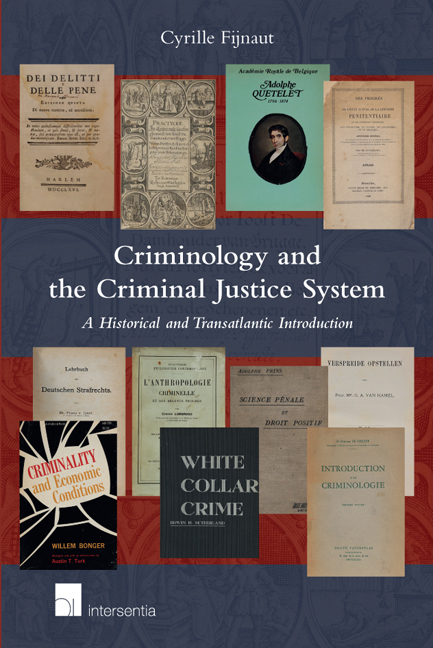Book contents
- Frontmatter
- Preface
- Contents
- Chapter 1 General Introduction
- Chapter 2 Origin of the Present-Day Criminal Justice System
- Chapter 3 Restructuring of the Criminal Justice System During the Enlightenment and the French Period
- Chapter 4 Emergence of the Scientific Study of Crime, Criminals, and the Combatting of Crime
- Chapter 5 Establishment of Criminology in Italy and France
- Chapter 6 Development of Criminology in German-Speaking Europe and the United Kingdom
- Chapter 7 Establishment of Criminology in the Netherlands and Belgium
- Chapter 8 Ideologisation of Criminology in the Third Reich and the Soviet Union
- Chapter 9 Reception of European Criminology in the United States
- Chapter 10 Transatlantic Integration of Criminology
- Chapter 11 General Conclusion
- Bibliography
- Register of Names
Chapter 10 - Transatlantic Integration of Criminology
Published online by Cambridge University Press: 11 October 2018
- Frontmatter
- Preface
- Contents
- Chapter 1 General Introduction
- Chapter 2 Origin of the Present-Day Criminal Justice System
- Chapter 3 Restructuring of the Criminal Justice System During the Enlightenment and the French Period
- Chapter 4 Emergence of the Scientific Study of Crime, Criminals, and the Combatting of Crime
- Chapter 5 Establishment of Criminology in Italy and France
- Chapter 6 Development of Criminology in German-Speaking Europe and the United Kingdom
- Chapter 7 Establishment of Criminology in the Netherlands and Belgium
- Chapter 8 Ideologisation of Criminology in the Third Reich and the Soviet Union
- Chapter 9 Reception of European Criminology in the United States
- Chapter 10 Transatlantic Integration of Criminology
- Chapter 11 General Conclusion
- Bibliography
- Register of Names
Summary
INTRODUCTION
This chapter aims to reconcile the past with the contemporary development of criminology. It does so primarily to help the reader understand the transition from the history of criminology as recorded in this book and its current state. It is therefore not the intention of this chapter to deal with the overall development of criminology as a whole since the 1960s as extensively as has so far been the case for certain periods and certain countries. For the same reason, it largely ignores the interaction between criminology and the criminal justice system. This chapter is intended mainly to act as a bridge between criminology past and present. Any broader aim would have necessitated writing a book within a book, so to speak.
In line with the distinction made so far between the history of criminology in relation to the criminal justice system in the United States and that history in a number of European countries, we will first consider the turmoil in the 1960s, 1970s, and 1980s in American criminology, which was due not only to the emergence of Marxist, radical, or left ist criminology, but also to the development of equally radical neo-classical but rightist criminology. In conjunction with this analysis, the spread of interactionist criminology will also be considered.
Consideration will then be given to how that discordant reform movement manifested itself in the development of criminology in most of the European countries dealt with in this book. We will look first at what happened in the United Kingdom. Subsequently, the focus will be on the impact of the movement on the continent, namely in Germany, France, Belgium, and the Netherlands, omitting only the evolution of criminology in Italy during the period concerned.
It should be noted that the structure of this chapter is not based only on the division applied in the previous chapters. Developments in the United States are this time explained prior to those in Europe because what took place in the former during the period concerned had much more influence, generally speaking, on developments in Europe, rather than vice versa. That was indeed to such an extent that it is no exaggeration to speak of a certain Americanisation of European criminology.
- Type
- Chapter
- Information
- Criminology and the Criminal Justice SystemA Historical and Transatlantic Introduction, pp. 463 - 544Publisher: IntersentiaPrint publication year: 2017



